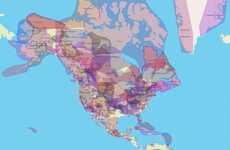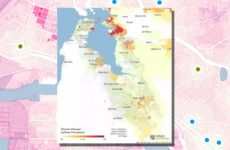
WWF Living Planet World Map of Ecological Footprints Shows Resource Consumers
Katie Cordrey — October 17, 2010 — Eco
References: footprintnetwork.org & worldchanging
The WWF Living Planet World Map of Ecological Footprints confirms that Western civilization has a disproportionately heavy ecological footprint. It should come as no surprise that the United States has the biggest per capita footprint, but Canada and Australia aren’t too far behind.
The map is part of a Living Planet Report that asserts the planet’s resources are being used at an unsustainable rate of 1.5 times that of nature’s ability to keep up. The disturbing map of ecological footprints shows darker colors for higher footprints.
The map is part of a Living Planet Report that asserts the planet’s resources are being used at an unsustainable rate of 1.5 times that of nature’s ability to keep up. The disturbing map of ecological footprints shows darker colors for higher footprints.
Trend Themes
1. Ecological Footprints - Disruptive innovation opportunity: Developing and implementing sustainable technology and practices to reduce ecological footprints.
2. Unsustainability - Disruptive innovation opportunity: Creating new solutions and business models that promote sustainable resource consumption.
3. Awareness - Disruptive innovation opportunity: Utilizing technology to raise awareness about the ecological footprints and promote environmentally conscious behaviors.
Industry Implications
1. Renewable Energy - Disruptive innovation opportunity: Advancing renewable energy technologies to reduce our ecological footprints and promote a sustainable future.
2. Green Building - Disruptive innovation opportunity: Developing innovative construction materials and techniques that minimize resource consumption and ecological footprints.
3. Sustainable Agriculture - Disruptive innovation opportunity: Implementing technology-driven solutions in agriculture to reduce the ecological footprints of food production.
5.2
Score
Popularity
Activity
Freshness























